Camera Rig Dissected – How I Made the BMPCC 6K Work for Me
The Blackmagic Pocket Cinema Camera has one of the best price/performance ratios out there. But it is of limited use out-of-the-box. Join me on my quest to turn the camera body into a decent BMPCC6K Rig.
This article is actually a two-in-one article. First, I want to give you a top to bottom look at my BMPCC6K rig and show off all the parts involved. Following that, I’ll give you some background on my journey from the old days and huge cameras to deciding to buy one of these Blackmagic cameras myself. You can use the index feature (little black dots) on the left side of the screen to easily scroll through the sections.
PART 1 – pocket form factor
I’m not sure why Blackmagic Design decided on a body design reminiscent of a (huge) stills camera when they developed the BMPCC4K and 6K. Maybe they thought users coming from a DSRL or mirrorless camera would feel more at home with the form factor. Or perhaps it was cheaper to produce.
Whatever the reason was — the form factor sucks, and out-of-the box the camera is pretty unusable for regular shooting conditions: The very dark and non-articulating monitor makes it hard to work outdoors, the high power consumption calls for bags full of batteries to last a shooting-day and missing built-in ND filters require at least screw-on filters to stop down to a decent working aperture.
I never planned to use the BMPCC6K for anything else than streaming, so all these concerns did not really bother me: I put it on a tripod, used a smallHD FOCUS 5 as a on-camera monitor, stuck a SIGMA 18-35 on it and streamed away.
 Blackmagic Pocket Cinema Camera 6K. Awkward Form Factor.Image Credit: Blackmagic Design
Blackmagic Pocket Cinema Camera 6K. Awkward Form Factor.Image Credit: Blackmagic Design
However, if you are a gearhead like me, you will understand that I started playing around with the device to see what it could do beyond its capabilities in combination with the Atem Mini Pro.I was impressed by the image quality, to say the least. Even though Blackmagic RAW is not a true RAW format in a sense, it allows very hard grading before it falls apart and we all know ProRes is a much more solid codec than XAVC. Skin tones are beautifully rendered and the dynamic range is lavish.
Making it work
I started experimenting with how I could make the BMPCC6K Rig work as a “normal” camera for as cheap as possible to bridge the gap until I could safely afford the C300MkIII.
I immediately felt a strong flashback to 2009, when I tried to make my Canon 7D useful as a video-camera by adding base-plates, handles, rods, and all the other bells and whistles. It was an expensive endeavor because there were no manufacturers selling affordable parts for rigging back then.A lot has changed and nowadays there are a ton of third-party manufacturers making good-quality accessories like Shape, Tilta, Wooden Camera, and SmallRig.
As I already had a couple of SmallRig accessories lying around, I decided to stick with their products plus their price/quality ratio is pretty decent.I was in no big hurry, so I took it slow and ordered a couple of items at a time to try them out and order something else if it did not work the way I expected. It took me the better part of three months, but now I’m happy with how the BMPCC6K handles.
The camera
I don’t want to go into details about the BMPCC6K. We already have a couple of articles covering the device. For example here and here. It’s worth mentioning however, that with the camera you’ll also get a DaVinci Resolve Studio license thrown in, which makes the device even more affordable. If you don’t already own a copy.
 The Basic Building Blocks of the BMPCC6K Rig. Image Credit: CineD
The Basic Building Blocks of the BMPCC6K Rig. Image Credit: CineD
To use the Blackmagic RAW codec (BRAW) you need to at least run you footage through Resolve anyway, so why not edit with it?
Blackmagic Design Pocket 6K Cinema Camera, B&HBlackmagic Design Pocket 6K Cinema Camera, CVP
Caging the animal
To add stuff securely to the BMPCC6K Rig, a cage is the best option. I thought of getting the BMPCC4K/6K half-cage that SmallRig offers to keep the weight and size down for when I use the camera on a gimbal, but ultimately decided against it and got the full cage (№ 2203B) for stability reasons.
Full Cage for Blackmagic Pocket Cinema Camera 6K/4K, B&HFull Cage for Blackmagic Pocket Cinema Camera 6K/4K, CVP
To protect the vulnerable HDMI and USB-C ports of the BMPCC6K I got the SmallRig (№ 2094) cable clamp. It screws to the cage and clasps the cables laterally. While does not really offer protection against cables being yanked out of their receptacles (unless you really tighten it down hard) it offers good protection against the plugs being bent in their sockets, especially when the camera is transported in a bag.
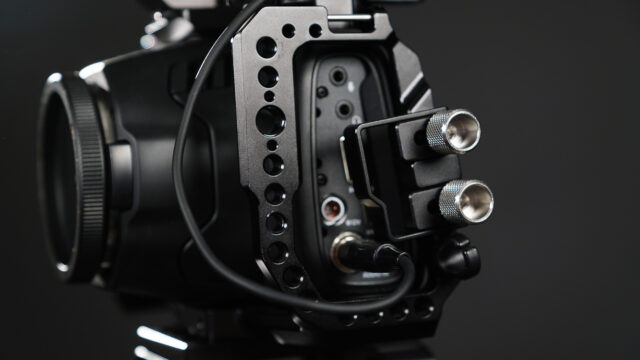 The Cable Clamp protects the vulnerable Ports. I removed the plastic Port Covers that come with the BMPCC6K. Image Credit: CineD
The Cable Clamp protects the vulnerable Ports. I removed the plastic Port Covers that come with the BMPCC6K. Image Credit: CineD
SmallRig HDMI and USB-C Cable Clamp, B&HSmallRig HDMI and USB-C Cable Clamp, CVP
Get a handle on things
To carry the rig, I got the SmallRig (№ 2049) top handle. It offers a 15mm rod clamp to fit a short 15mm rod (№ 1049) transversely. I needed that to attach the SmallRig (№ 1993) universal shotgun microphone mount. The mount is compact and features only rudimentary noise insulation via rubber elements, but it works better than built-in microphone mounts on other cameras.
 The Microphone Assembly of the BMPCC6K Rig. Image Credit: CineD
The Microphone Assembly of the BMPCC6K Rig. Image Credit: CineD
The short rods feature threads at either end for which SmallRig offers a set of Rod Caps (№ 1617). With these Rod Caps attached the rod can not slide out of it’s hole in the Top Handle and the Microphone Mount can not fall off the camera, if you fail to tighten it before bagging the rig.
SmallRig Cold Shoe Mount Top Handle 2094, B&HSmallRig Cold Shoe Mount Top Handle 2094, CVPSmallRig 15mm Aluminum Rods, B&HSmallRig 15mm Aluminum Rods, CVPSmallRig 15mm Rod Cap, B&HSmallRig 15mm Rod Cap, CVPSmallRig Universal Shotgun Microphone Mount, B&HSmallRig Universal Shotgun Microphone Mount, CVP
Rod support
There are lots of options for adding 15mm rods underneath the BMPCC6K rig. I have no Speed Booster, so I got the simple but versatile SmallRig (№ 1798) kit, which is basically two cheeseplates held together by two 15mm rod clamps.
The quick and the… lock
I use the Kessler KWIK mounting system to connect the rig to the tripod. It’s neat because it’s Arca Swiss compatible and I can easily mount all sorts of stuff (Slider, PXW-FS7, FUJIFILM X-T4, Ronin-S…) on the tripod and all other KWIK equipped supports without having to screw/unscrew the tripod’s dovetail plate constantly.
That only makes sense if you buy a bunch of KWIK Receivers to have one on every piece of support equipment that you need to put your camera on. Of course, you could skip the quick-mount system and fix your tripod plate right underneath the baseplate.
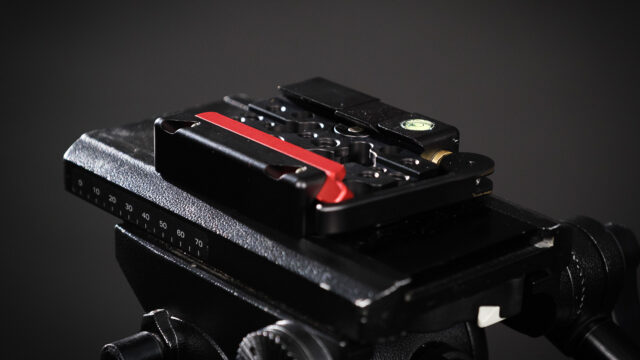 The Kessler Crane KWIK Receiver. A sturdy and versatile quick release systemfor medium-sized camera rigs. Image Credit: CineD
The Kessler Crane KWIK Receiver. A sturdy and versatile quick release systemfor medium-sized camera rigs. Image Credit: CineD
Smallrig Tripod Mounting Kit, B&HSmallrig Tripod Mounting Kit, CVPKessler Crane Kwik Release Receiver, B&HKessler Crane Kwik Short Camera Plate, B&HKessler Crane Kwik Release Receiver, CVPKessler Crane Kwik Short Camera Plate, CVP)
To save a tiny bit of weight, I got a pair of 45cm carbon-fiber 15mm rods. Depending on your lenses you could opt for shorter rods. I needed to account for a rather long zoom lens, which has its focus ring to the front. More on that later.
SmallRig 15mm Carbon Fiber Rod – 45cm 18″, CVPSmallRig 15mm Carbon Fiber Rod – 45cm 18″, CVP
Media
The BMPCC6K (and 4K) offers the great feature of being able to record directly to inexpensive USB-C SSDs. I already owned a bunch of Samsung T3 and T5 SSDs, so I decided not to invest in rather expensive CFast cards for the time being. To attach the T3s and T5s SmallRig makes a dedicated mount. (Be careful here, because the newer T7 SSDs don’t fit into this mount!).
So far I had no problems with recording to those SSDs. However as I plan to invest in a Canon C300MkIII this year, I will get CFast cards that both cameras can then potentially share – nice!
Samsung 1TB T5 B&HSmallRig Mount for Samsung T5 SSD, B&HSmallRig Mount for Samsung T5 SSD, CVP
Viewfinder
Maybe the biggest drawback of the BMPCC6K and 4K is the fixed built-in monitor. There are 3rd party solutions to make the monitor tilt, but that would not make sense in the way I plan to use the camera. Fortunately, I had a smallHD FOCUS 5” monitor that I no longer use.
SmallRig offers an EVF mount bracket with a nato-clap that slides elegantly onto a nato-rail on the left side of the BMPCC6K rig cage. First I tried to mount the SmallHD 5” directly on the EVF mount, but since it only has a single 1/4” screw hole at the bottom, the monitor tended to twist quite easily. Because of that and to better protect the SmallHD, I got the SmallRig cage (№ 2249) for the SmallHD Focus. Now the monitor is protected and does not twist on the EVF mount when I press my eye against it.
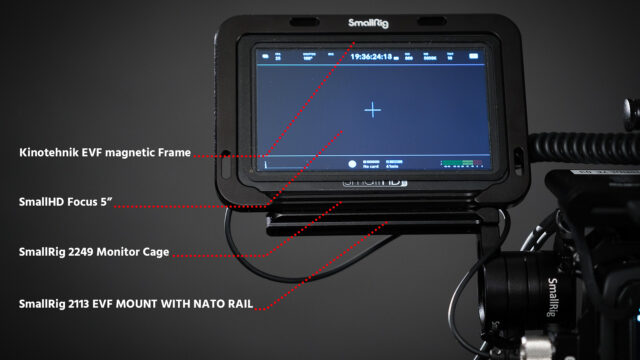 The BMPCC6K rig’s Viewfinder Assembly. Image Credit: CineD
The BMPCC6K rig’s Viewfinder Assembly. Image Credit: CineD
The eye of the beholder…
… is not as good as it once was. Therefore (and to better see in bright daylight), I ordered the Kinotehnik viewfinder for the BMPCC6K/4K. It’s basically a loupe that attaches to the BMPCC6K rig with a magnetic frame that gets glued on. The beauty of this solution is that it comes with two sticky frames and the size fits both the BMPCC6K/4K and the SmallHD Focus monitor. (So I have the option of stripping down the camera completely and use it “naked” with the Kinotehnik viewfinder, if I ever need to do some sneaky shooting.)
 The Kinotehnik Viewfinder Loupe. It also fits directly on the BMPCC6K body. Image Credit: CineD
The Kinotehnik Viewfinder Loupe. It also fits directly on the BMPCC6K body. Image Credit: CineD
There are two drawbacks to this solution: First, the magnetic attachment is not super-strong. It’s ok when operating the BMPCC6K rig, but the EVF loupe can fall off, when the camera is bumped when carried. The second drawback is that the EVF loupe does not have eyesight compensation. Luckily Kinotehnik offer a set of diopters (+1,+2,+4) to compensate for eyesight.
SmallHD FOCUS OLED Monitor (Kit for Panasonic) B&HSmallHD FOCUS OLED Monitor CVPSmallHD Micro-HDMI to HDMI, B&HSmallHD Micro-HDMI to HDMI, CVP)SmallRig EVF Mount with NATO Rail, B&HSmallRig EVF Mount with NATO Rail, CVPSmallRig Monitor Cage, B&HSmallRig Monitor Cage, CVPKinotehnik Viewfinder B&HKinotehnik Viewfinder CVPBluestar Eyecushion B&HBluestar Eyecushion CVP
Lenses
I already own a set of EF prime lenses that I have used for years with the original C300 and later with the Sony FS7 via a Metabones adapter. They are wonderful lenses, but primes are not always practical. The Sony-18-105mm lens I used on the FS7 can not be adapted to EF, so I looked into affordable, yet capable EF zooms. For everyday use I wanted a range from around 16mm to 100mm.
The best affordable solution I found were the SIGMA 18-35mm f1.8 and the SIGMA 50-100mm f1.8 Art lenses. Both have excellent image quality and together they cover all the focal lengths I need. The gap between 35mm and 50mm is not really an issue to me and the constant f1.8 on both lenses is enough to get shallow Depth of Field in any situation. Both lenses are actually sharp and usable at their f1.8 “full open” setting. There are some issues with those lenses, the worst being the strong focus-breathing of the SIGMA 50-100mm, but in my opinion you won’t get anything better without shelling out a lot more dough.
Sunglasses
To control the light I opted for a set of Gobe screw-on ND filters for each lens. The SIGMA lenses don’t share a common front-thread diameter (the 18-35 is 77mm and the 50-100 is 82mm.). That’s not necessarily a bad thing: The NDs can stay on the lenses, when you want to swap glass in the same setup. Of course you could use variable NDs, but I don’t like using those because they are actually polarisers and have strange effects on skin and sky.
Sigma 18-35mm f/1.8 DC HSM Art Lens for Canon EF, B&HSigma 18-35mm f/1.8 DC HSM Art Lens for Canon EF, CVP)Gobe 72mm ND Family 2Peak ND Filter Kit, B&HSigma 50-100mm f/1.8 DC HSM Art Lens for Canon EF, B&HSigma 50-100mm f/1.8 DC HSM Art Lens for Canon EF, CVPGobe 82mm ND8, B&HGobe 82mm ND4 2Peak ND 0.6 Filter, B&H
The EF lens mount is not a super-solid connection. When you attach a longer, heavier lens like the SIGMA 50-100mm and use a Follow-Focus, the force that is exerted by the focus gear, slightly bends the lens in the mount. Resulting in a slight, but noticeable image shift. To stabilize the lens I got the SmallRig (No. 2152) Universal Lens support. They offer another lens support that can screw directly in the SIGMA 50-100’s tripod support, but I could not use it on the SIGMA 18-35. The 2152 works fine with both lenses and dampens much of the ugly image-shift.
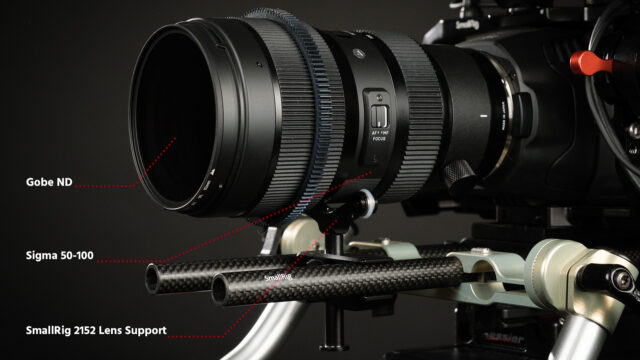 The Sigma 50-100 with ND Filter and Lens Support on my BMPCC6K rig.Image Credit: CineD
The Sigma 50-100 with ND Filter and Lens Support on my BMPCC6K rig.Image Credit: CineD
SmallRig 15mm LWS Universal Lens Support, B&HSmallRig 15mm LWS Universal Lens Support, CVP
Follow focus
To be able to use my existing Shoot35 Follow Focus, I ordered two seamless .8 pitch focus gears that slide on the rubber rings of the SIGMA 18-35 and 50-100 respectively. I haven’t received those yet, so for the images I used a simple rubber focus gear I had lying around.
Shoot35 CINEfocus Pro Follow-FocusFollow Focus Gear for Sigma 18-35mm f1.8Follow Focus Gear for Sigma 50-100mm f1.8
Power
To power the BMPCC6K and the SmallHD Focus monitor I got the new SmallRig (№ 3059) V-mount battery plate. It has enough outputs (2x 12V barrel, 1x 8V barrel, 1x D-Tap, 1x USB-A) to power both devices and connections to spare for a wireless audio receiver, an on-camera light and a wireless video transmitter I plan to get very soon.
I already owned V-lock batteries, but I got an extra pair of SWIT PB-S98S for this rig. The batteries feature an LCD display that shows the remaining running time based on the power drawn, which is quite useful because the BMPCC6K/4K does not show remaining battery time when powered through the Lemo-port.With a full charge under normal indoor conditions a single SWIT PB-S98S powers the rig for more than 6 hours.To run the SmallHD monitor from the V-mount battery as well, I got a dummy battery off Amazon.
 SWIT PB-S98S battery and SmallRig V-mount battery plate.
SWIT PB-S98S battery and SmallRig V-mount battery plate.
SWIT PB-S98S V-Mount Battery, B&HSWIT PB-S98S V-Mount Battery, CVPSmallRig V-Mount Battery Adapter Plate, B&H
Audio
The BMPCC6K features a single mini-XLR input that can provide phantom power to a condenser microphone, so I got a mini-XLR male plug, a bit of cable and an XLR female plug and soldered my own cable to connect a the short Oktava MK-12 cardioid to act as a on-board scratch mic. If I’m on a small interview assignment I’d use the XLR-in for a boom-mic and the BMPCC6K’s TRS input for a radio-mic.
If I have to record more than two mics, I usually have the sound people feed a mix into the BMPCC6K as a scratch track and synch the seperately recorded audiotracks, that I get from them, in post.I do miss a limiter and a low-cut filter in the BMPCC6K, but other than that the sound quality of the recordings is good enough.
Cable management
With a rig you’ll alwyas have a lot of cables flying around: power from the battery plate to the camera and the viewfinder, HDMI to the viewfinder, audio from the camera to the microphone and USB-C to the SSD in my case.To have all the cables as neatly as possible, I used a set of Sprig cable organizers.
Sprigs are little looped clamps that can be mounted in any 1/4″ thread anywhere. To be honest they are a little on the expensive side, considering they are cheap little plastic thingies and of course one could do with cable-ties or velcro ties, but sprigs look better and cables can be replaced faster that with velcro ties.
 Sprig Cable ties. Image Credit: CineD
Sprig Cable ties. Image Credit: CineD
Transportation
I like to have everything for a given camera system in one bag, so I just need to grab it and be on the road without thinking. It also sucks to have to break apart the camera-rig between sets or jobs, so I got the large Tenba Cinelux Video Shoulder Bag 24.
 Tenba Cineluxe 24 Bag. Big enough to fit my BMPCC6K rig. Image Credit: CineD
Tenba Cineluxe 24 Bag. Big enough to fit my BMPCC6K rig. Image Credit: CineD
It’s big enough to hold the camera fully rigged with the SIGMA 50-100mm lens attached. I just have to remove the follow focus and handgrips, all the accessories, an extra battery, the Sigma 18-35 and a dual v-mount charger also fit. The downside of this Tenba bag is the fact that it does not have rollers. However it has straps on the back, so it can go on top of an existing trolley.
Tenba Cineluxe Video Shoulder Bag 24, B&HTenba Cineluxe Video Shoulder Bag 24, CVP
Conclusion
I made a spreadsheet to find out what I spent on the rig as I detailed it in this article. I’m not going to publish it, because — as I said — I already owned some of the stuff and guesstimated it’s oiginal price. However as the title of this piece claims: it’s just over €6K.
Depending on where you draw the line what is part of the rig or if you already have lenses and don’t need the quick-lock system or batteries you’ll end up spending less the €5K. That is pretty amazing considering the rig allows me to shoot 6K RAW rather professionally, includes a license of a pretty awesome video postproduction software and a bag!
I have only been using the rig only on a limited number of jobs, but it has proven to be reliable so far. A green screen-gig revealed that BRAW keyes flawlessly.
I keep a couple of extra cables in the bag, just to have a spare, when a connector breaks. A bit of healthy paranoia is in order here, I think.
 Whats in the bag?! Image Credit: CineD
Whats in the bag?! Image Credit: CineD
Rigging a camera these days results in way better builds than ten years ago, but my BMPCC6K solution still suffers…
Some issues
The lack of built-in ND filters and the resulting screwing- and unscrewing of ND filters on the lenses is annoying but manageable. When shooting bigger budget projects with an assistant, I’ll take my 4×4 mattebox. That is quicker to use, but is a bit too cumbersome when soloing.
Kitted out like that, the BMPCC6K is not “Pocket” anymore. It’s a serious rig, especially with the SIGMA 50-100mm lens attached. I’m used to heavy camera rigs and find that a little inertia makes for much better handheld work. I won’t be climbing mountains with this camera, so I’m ok with a little mass.The biggest complaint I have is the lack of a second video-output on the BMPCC6K. The only HDMI-out is used by the SmallHD monitor.
The BMPCC6K Pro
While in the middle of pimping my BMPCC6K, Blackmagic Design came out with the 6K “PRO” — an upgraded version of the “Pocket 6K”.
It is an impressive update, which makes good some of the shortcomings that the original 6K Pocket had. Does that mean my rig is obsolete now? With any other camera that could have easily been the case, but with the BMPCC — and that’s the beauty of it — it’s not!
If I would get a BMPCC6K PRO in the near future, all I would likely need to swap will be the camera cage. All the other accessories — except the screw-on ND filters — are still useful.
Future plans
The handgrips you see in the photos are old Vocas grips that I had for ten or twelve years. I don’t think they make them anymore. They have served me well, but I’m looking to replace them with something more collapsible. The shoulder-pad is SmallRig, but that is not sold anymore as well. I have to spend a little more time to optimise the handheld-ergonomics. (Note: The handgrips and shoulder pad are not part of my ~€6K price calculation at present.)
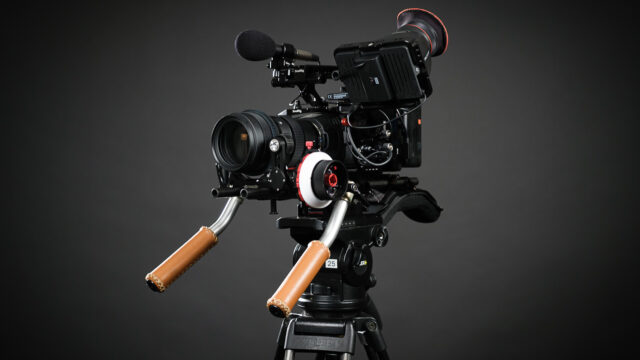 The finished BMPCC6K rig as I use it now. Image Credit: CineD
The finished BMPCC6K rig as I use it now. Image Credit: CineD
In the near future I’m also planning to get a PL-mount adapter to be able to rent proper cine-glass if the job calls for it.For most of my jobs, I need to feed the camera image to a client monitor. To solve the problem of the missing second video output of the camera I’m thinking of getting a Hollyland MARS 300 PRO wireless video system because the transmitter has an HDMI loop-through. I want to test this first, but I could not get my hands on a unit yet.
Disclaimer
While I admit that this article up until now might feel like a (very) long advertising piece, I assure you that I have paid for all the gear with my own money. I was never asked by SmallRig or any other manufacturer mentioned in this article to endorse their products. I am sure that rig parts by other manufacturers are equally good or maybe better than what I used, but that’s what I went for and it works for me.
I spent a lot of time polishing this configuration and wanted to share my findings with you guys, so maybe it helps with your decisions. You don’t find negative views about any of the equipment used, because gear that didn’t work, did not make it in the rig.
That being said: If you want to support CineD and are in the market for some of the products I mentioned in this article, please consider using our affiliate links. Thanks!
PART 2 – The old days
This is part 2 of this article and we’ve made it through my entire BMPCC6K rig! Now it’s time to take a look back in time and explain why on earth I got this camera from Blackmagic Design. Refill your coffee and let’s go:
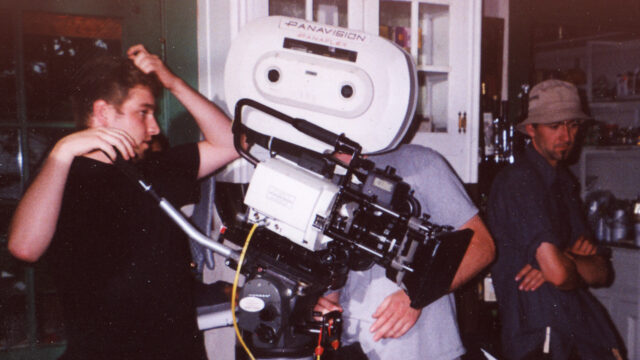 Author scratching his head behind a Panavision Panaflex Platinum — this very camerawas used on Season 1 of the “Sopranos”. Image Credit: unknown
Author scratching his head behind a Panavision Panaflex Platinum — this very camerawas used on Season 1 of the “Sopranos”. Image Credit: unknown
When I started out in the business in the late 1990ies, I shot on 35mm film. If the budget wasn’t there for that, I shot on 2/3” CCD or CMOS cameras.There was a brief period of time when using special adapters on regular 2/3” camcorders would allow getting a “film look” on Digibeta or HDCam. The setups were bulky and cumbersome, to say the least.
 Sony DVW-700 with Pro35 Adapter and Zeiss Superspeed Lens. Image Credit: Author
Sony DVW-700 with Pro35 Adapter and Zeiss Superspeed Lens. Image Credit: Author
The DSLR revolution and its pain points
Then came the Canon 5D and changed everything. That includes sparking the inception of the fine publication you are currently reading: CineD (formerly cinema5D).Like everybody and their dog, I shot on a Canon DSLR for a while, when it came out.
The hype around shooting on DSLRs was big back then. I had to shoot a mayor budget commercial for a large Austrian Telecom company on the 5D instead of 35mm film. Just because the advertising agency people thought it was cool.
Interestingly enough, shooting with a DSLR in a controlled studio setup was much easier than in a run- and gun scenario. On a documentary shoot, changing lenses, putting NDs, feeding director’s monitors, and dealing with dual-system audio is just a drag.
However, the look of the 5D’s sensor compared to 2/3” sensors was “cinematic”. So I put up with the ergonomic nightmare for a while.I have never been a big fan of using DSLRs or mirrorless cameras for video. Putting photo-bodies on a gimbal as a “B” or “C” camera is fine, but shooting on them all day gets tiresome. They are small, versatile, and perfect for light travel, vlogging, and private use. For my line of work, I take a full-featured cinema camera over a mirrorless body any day.
Super 35 sensor camcorders
Eventually, camera manufacturers caught up with the Super35mm trend. When they did, I instantly upgraded from the Canon DSLR back to a “real camera”: the original Canon C300. I was so happy I had tears in my eyes.I loved the C300, shot commercials, promos, image films, and even a feature film on it.
In 2015 I abandoned Canon and got the Sony PXW-FS7 because of the rather bad price/performance ratio of the C300 Mark II. Apart from a ~€5000 price difference, the final dealbreaker was the C300 Mark II’s inability to shoot 4K50p. Clients increasingly started to ask for slow motion and 4K back then.
 The Author operating his trusty PXW-FS-7. Image Credit: Roland Rudolph
The Author operating his trusty PXW-FS-7. Image Credit: Roland Rudolph
The Sony PXW-FS7 is a great camera. It has travelled across the globe with me and has never let me down. I still don’t hesitate to take it out for most jobs.
Time to upgrade
The Super 35 Exmor sensor inside the FS7 was developed for the Sony PMW-F5 and PMW-F55 cameras. These were introduced in 2012 and it is getting a bit long on the tooth. The image looks soft and dull compared to more recent offerings.
Apart from the aging sensor the codec of the FS7 isn’t dope either. XAVC-I was great in 2014 when the FS7 MkI came out. However, it is not en-par anymore with ProResRAW, Blackmagic RAW, and CanonRAW.
Whenever I did higher-end or green screen work on the PXW-FS7, I’d always rent the XDCA-FS7 unit to get RAW out of the FS7. And then record externally. Despite that, fine details never keyed properly because of the rather strong compression of XAVC and the inherent softness of the sensor. Because 99% of my work was delivered in HD the downscaling hid most of those flaws. Then clients started asking for 4K deliverables. So I figured, it’s time to upgrade.
Research … what to choose?
In mid-2019, I started looking into a replacement for the PXW-FS7.The Sony PXW-FX9 was a disappointment for me: The new sensor is great and the auto-focus is awesome, but the internal codec is the same relatively weak XAVC-I as in the FS7 and I’d still have to rent Sonys extension-unit (now cleverly named XDCA-FX9) to get RAW out of the FX9, and record to ProRes externally.
I got the same feeling that I have had with the C300 Mark II: was the PXW-FX9 is deliberately crippled to protect sales of the more expensive cameras?
Shortly after the FX9 announcement, Canon came out with the C500 Mark II that looked a lot more interesting than the Sony FX9, but it was more expensive and beyond my budgetary constraints.
 Canon EOS C500MkII. Image Credit: Canon
Canon EOS C500MkII. Image Credit: Canon
As happily I’d like to put down more money to get a better camera, I still have to factor in the economic aspect: Making the money back on any given camera in two to three years and earn money with it for another year or two to get a decent return on the investment. Owning a camera does not make much sense otherwise.
With a ~€25,000 C500 Mark II camera package I would need one or two more years to break even. By that time the camera is mostly obsolete.
Let me be clear: The C500 MkII body is “only” around €15K, but for a ready-to-shoot package I’d need to add a viewfinder, baseplate, cage, batteries, and other accessories that bump the price quickly up to the €25K mentioned above. The Canon viewfinder alone is around €3500.
To compensate I would have to raise my rate accordingly, but most clients are not prepared to pay significantly more for no obvious benefit, and they are right. For me as owner/operator, camera packages around €15.000 to €18.000 proved to be the sweet-spot in the last 10 years or so. When a job calls for a higher quality camera, I always turn to the rental equipment.
Full Frame?
Both the C500 Mark II and the FX9 are so-called “Full Frame” cameras. Some of the lenses I own would not work without using the crop. Another argument against the C500 Mark II and the PXW FX9.I honestly don’t care much for “Full Frame”.Most films in the history of cinema were shot on 35mm film going through the camera vertically. 35mm was how I learned my craft and still is, how I see the world. Super 35mm is closer to 35mm Motion Picture film than “Full Frame”.
When camera manufacturers talk about “Full Frame” cameras, they actually talk about the size of the negative in photographic 35mm cameras where the 35mm film went through horizontally and the negative area was bigger than in motion picture film. (Before you yell at me: I do know about Vista Vision, but that technology was niche at best.)When people started shooting video on the Canon 5D Mark II (A digital Full Frame stills camera) the myth about the “Full Frame look” started, but I could honestly never see the advantage over Super35mm sensors.
My views on Full Frame
I’ll go a little into my views on “Full Frame” in this chapter, so feel free to skip it, if you are a “Full Frame” afficionado.The whole “crop-factor” issue started off by people comparing Super35 with photographic “Full Frame”.Every Director of Photography worth his salt knows how a 16mm lens or a 35mm lens “looks” and does not start to calculate crop factors in their head to compare it.
Steve Yedlin — DP of films like “The Last Jedi” and “Knives Out” has similar views on this issue. So if you want to go all-out nerdy about it, head over to his blog.The gist of it is: When using a “Full Frame” digital cinema camera you’ll get a wider Field of View (FoV) than Super35 (by a factor of approx. 1.5x). Inversly you can use a slightly longer lens on “Full Frame” to get the same FoV compared to a Super 35mm camera, which gives you a little less depth-of-field, but that’s about it.
No magic here
The important thing to remember here is that a 24mm lens stays the same 24mm lens no matter if you stick it on an MFT, Super35, or “Full Frame” camera. You just see less of the image it projects onto the sensor, but its optical characteristics (distortion, optical compression, etc.) stay the same.In other words: you get the same FoV but you do not get the same “feel” when you use a 16mm lens on a Super 35mm camera as you would by using an “equivalent” 24mm on a “Full Frame” sensor.
The difference between Super35 and “Full Frame” is simply not worth the expense and is more of a marketing tool of camera manufacturers to replicate the success they had when they shifted from 2/3” sensors to Super35. Just open the lens one more stop and be done with it.True “large format” cinematography, like 65mm motion picture film, is a different beast altogether the image really looks and feels quite different.
A little side-note: The negative-size that is now marketed as “Full Frame” was called “Kleinbild” in german, which translates into “Small Picture”.
 35mm Stills Stock — where the “Full Frame” myth started.Image Credit Andrey Konstantinov, unsplash
35mm Stills Stock — where the “Full Frame” myth started.Image Credit Andrey Konstantinov, unsplash
Then came 2020
At the beginning of 2020 there was still no camera on the horizon that I felt comfortable to replace my FS7 with. I tended towards the Blackmagic Design Ursa Mini Pro that I used a couple of times. I loved it’s look and picture quality, but it’s a too heavy beast. Maybe — so I thought — Blackmagic Design would show something at the 2020 NAB that could be right for me.
 Canon EOS C300 Mark III. Can’t buy one yet. Image Credit: CineD
Canon EOS C300 Mark III. Can’t buy one yet. Image Credit: CineD
NAB was cancelled and March rolled around, the first Corona Lockdown hit, and everything grinded to a halt.In the midst of this mess Canon introduced the C300MkIII — it looked like the perfect camera for me. As we all know 2020 did not turn out to be what business-people call “reinvestment economy”. So I decided to postpone any purchases until the economy would pick up again and it was clear that I could afford the leasing rates for a new camera package.
A lot changed in 2020: I got into live-streaming, invested in an Blackmagic Design Atem Mini Pro ISO live-streaming mixer. I rented Blackmagic Pocket Cinema Cameras ( BMPCC) to use with the mixer and finally ended up buying a BMPCC6K to have at least one camera at hand for jobs. There was so much streaming going on that my usual rental-places had their BMPCCs rented out almost constantly.
I have let you in on my thoughts and presented the BMPCC6K rig: why how I built it. Now it’s your turn. Do you have different or better solutions? Questions? Tips? Please share them in the comments below.
The post Camera Rig Dissected – How I Made the BMPCC 6K Work for Me appeared first on CineD.
Read more: cined.com
The post Camera Rig Dissected – How I Made the BMPCC 6K Work for Me appeared first on Patrizia Wish.
source http://patriziawish.com/camera-rig-dissected-how-i-made-the-bmpcc-6k-work-for-me/
Comments
Post a Comment